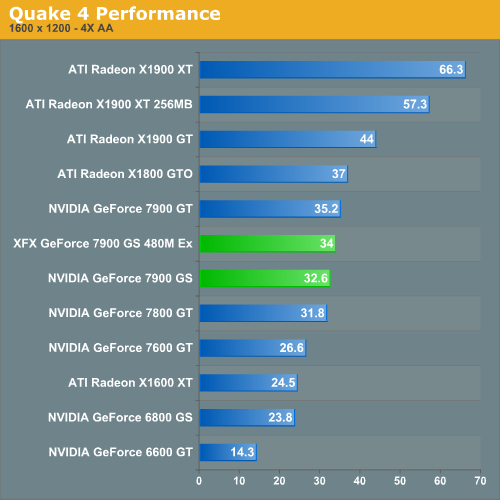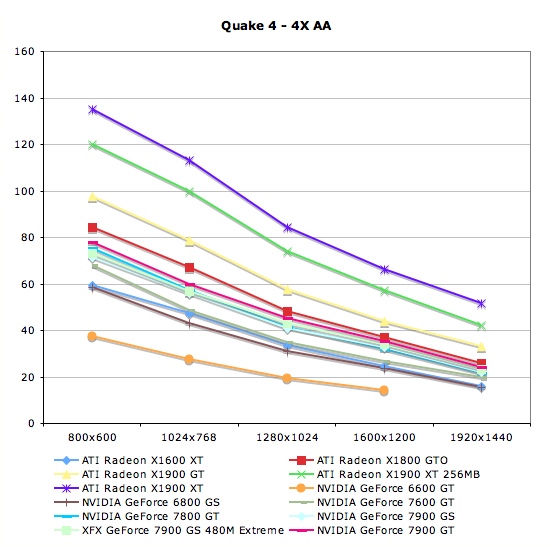Fall '06 NVIDIA GPU Refresh - Part I: GeForce 7900 GS
by Derek Wilson on September 6, 2006 9:00 AM EST- Posted in
- GPUs
Quake 4 Performance
There has always been a lot of debate in the community surrounding pure timedemo benchmarking. We have opted to stick with the timedemo test rather than the nettimedemo option for benchmarking Quake 4. To be clear, this means our test results focus mostly on the capability of each graphics card to render frames generated by Quake 4. The frame rates we see here don't directly translate into what one would experience during game play.
Additionally, Quake 4 limits frame rate to 60 fps during gameplay whether or not VSync is enabled. Performance characteristics of a timedemo do not reflect actual gameplay. So why do we do them? Because the questions we are trying to answer have only to do with the graphics subsystem. We want to know what graphics card is better at rendering Quake 4 frames. Any graphics card that does better at rendering Quake 4 frames will play Quake 4 better than another card for Quake 4. While that doesn't mean the end user will see higher performance in the game, it does mean that the potential for seeing more performance is there. For instance, if the user upgrades a CPU before the next graphics card upgrade.
What this means to the end user is that in-game performance will almost always be lower than timedemo performance. It also means that graphics cards that do slightly better than other graphics cards will not always show a tangible performance increase on an end user's system. As long as we keep these things in mind, we can make informed conclusions based on the data we collect.
Our benchmark consists of the first few minutes of the first level. This includes both inside and outdoor sections, with the initial few fire fights. We tested the game with Ultra Quality settings (uncompressed normal maps), and we enabled all the advanced graphics options except for VSync. Id does a pretty good job of keeping framerate very consistent, and so in-game framerates of 25 are acceptable. While we don't have the ability to make a direct mapping to what that means in the timedemo test, our experience indicates that a timedemo fps of about 35 translates into an enjoyable experience on our system. This will certainly vary on other systems, so take it with a grain of salt. But the important thing to remember is that this is more of a test of relative performance of graphics cards when it comes to rendering Quake 4 frames -- it doesn't directly translate to Quake 4 experience.

It seems that even an overclock can't save NVIDIA's newest part from succumbing to the latest ATI OpenGL enhancements that have drastically improved Doom 3 engine based game performance. Of course, not all OpenGL games faired well with the latest round of drivers from ATI, with City of Heros/Villains performing very poorly in spite of its use of OpenGL. ATI cards seem to do very well in this benchmark indeed with the X1900 GT coming out the clear performance and value winner.

| Quake 4 - No AA | |||||
800x600 |
1024x768 |
1280x1024 |
1600x1200 |
1920x1440 |
|
| ATI Radeon X1600 XT | 77.1 |
61.8 |
43.8 |
34.5 |
25.3 |
| ATI Radeon X1800 GTO | 114.7 |
93.5 |
68.9 |
53.9 |
40.3 |
| ATI Radeon X1900 GT | 130.8 |
109.6 |
82.7 |
65.5 |
51.7 |
| ATI Radeon X1900 XT 256MB | 148.3 |
129.2 |
101.8 |
82 |
65.6 |
| ATI Radeon X1900 XT | 159.2 |
145.2 |
117.5 |
95.4 |
75.7 |
| NVIDIA GeForce 6600 GT | 54 |
42.4 |
31.3 |
23.5 |
15.5 |
| NVIDIA GeForce 6800 GS | 78.9 |
58.4 |
44.8 |
34.7 |
23.5 |
| NVIDIA GeForce 7600 GT | 96.5 |
71.2 |
54.6 |
41.7 |
32.4 |
| NVIDIA GeForce 7800 GT | 98 |
75.3 |
56.3 |
45.8 |
36.9 |
| NVIDIA GeForce 7900 GS | 92.5 |
70.2 |
58.2 |
44.8 |
38.3 |
| XFX GeForce 7900 GS 480M Extreme | 94 |
76.1 |
59.3 |
46.4 |
40.1 |
| NVIDIA GeForce 7900 GT | 105.2 |
80.6 |
63.6 |
49.9 |
42.2 |

Enabling 4xAA serves to clench Quake 4 as a benchmark that greatly favors ATI hardware when running at the highest possible quality settings. This is the exact opposite of what we have been saying about Quake 4 performance ever since the game launched, but it seems ATI has finally solved their OpenGL performance issues -- at least with this particular engine.

| Quake 4 - 4X AA | |||||
800x600 |
1024x768 |
1280x1024 |
1600x1200 |
1920x1440 |
|
| ATI Radeon X1600 XT | 59.4 |
47.5 |
33.7 |
24.5 |
15.7 |
| ATI Radeon X1800 GTO | 84.2 |
67.1 |
48.3 |
37 |
25.7 |
| ATI Radeon X1900 GT | 97.7 |
78.6 |
57.5 |
44 |
33.1 |
| ATI Radeon X1900 XT 256MB | 119.8 |
99.8 |
73.9 |
57.3 |
42.1 |
| ATI Radeon X1900 XT | 134.9 |
113 |
84.2 |
66.3 |
51.5 |
| NVIDIA GeForce 6600 GT | 37.6 |
27.7 |
19.3 |
14.3 |
|
| NVIDIA GeForce 6800 GS | 58.7 |
42.8 |
30.9 |
23.8 |
15.3 |
| NVIDIA GeForce 7600 GT | 67.9 |
48.5 |
34.7 |
26.6 |
19.9 |
| NVIDIA GeForce 7800 GT | 75.1 |
57.1 |
41.2 |
31.8 |
21.5 |
| NVIDIA GeForce 7900 GS | 71.6 |
55.8 |
40.9 |
32.6 |
22.1 |
| XFX GeForce 7900 GS 480M Extreme | 73.3 |
56.9 |
43 |
34 |
23.1 |
| NVIDIA GeForce 7900 GT | 78 |
60 |
45.1 |
35.2 |
23.9 |










29 Comments
View All Comments
munky - Wednesday, September 6, 2006 - link
FEAR is a DX9 game, not OpenGL...
DerekWilson - Wednesday, September 6, 2006 - link
I'm looking into this at the moment but having trouble finding documentation on it.I suppose, as I was recently testing quad sli and saw huge performance increases, I assumed the game must be using the 4 frame afr mode only possible in opengl (dx is limited to rendering 3 frames ahead). I'll keep looking for confirmation on this ...
MemberSince97 - Wednesday, September 6, 2006 - link
Jupiter EX is a DX9 rendering engine...DerekWilson - Wednesday, September 6, 2006 - link
corrected, thanks ... now I have to figure out why FEAR likes quad sli so much ...MemberSince97 - Wednesday, September 6, 2006 - link
Nice writeup DW, I really like the mouseover performance % graphs...PrinceGaz - Thursday, September 7, 2006 - link
So do I, but there is one errorThat should be 14% and 25% advantages
The 7900GS has 20 PS while the 7900GT has 24 PS. That makes the 7900GS 20% slower than the 7900GT, but it makes the 7900GT 25% faster than the 7900GS. It's important to remember which one you're comparing it against when quoting percentages.
Hopefully the percentage performance difference in the graph itself was calculated correctly, or at least consistently.
PrinceGaz - Thursday, September 7, 2006 - link
Ooops sorry, please ignore my post. For some reason I thought for a moment the 7900GS had 16 PS and the 7900GT had 20 PS (despite writing the correct values in my comment). The article is correct, I was just getting confused.PS. an edit function would be nice.
Frackal - Wednesday, September 6, 2006 - link
There is no way an X1900xt gets 75fps at 1600x1200 4xAA, at that same resolution and AA setting I get well over 120-130fps average with an X1900xtx. Most sites show it hitting at least 100+DerekWilson - Wednesday, September 6, 2006 - link
if you use the built in demo features to run a timedemo with dice's own calculations you will get a very wrong (skewed upward) number. Dice themselves say that results over 100 fps aren't reliable.the problem is that they benchmark the load screen, and generally one card or the other will get better load screen performance -- for instance, the x1900 gt may get 300+fps while the 7900 gt may only get 200fps. (I just picked those numbers, but framerates for the load screen are well over 100 fps in most cases and drastically different between manufacturers).
not only does no one care about this difference on a load screen, but it significantly interferes with benchmark numbers.
the timedemo feature can be used to output a file with frametimes and instantaneous frames per second. we have a script that opens this file, removes the frame data for the load screen, and calculates a more accurate framerate average using only frame data for scenes rendered during the benchmark run.
this will decrease over all scores.
we also benchmark in operation clean sweep which has a lot of fog and water. we use a benchmark with lots of smoke and explosions and we test for some ammount of time in or near most vehicles.
splines - Wednesday, September 6, 2006 - link
Ownage approved.